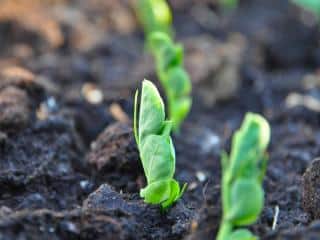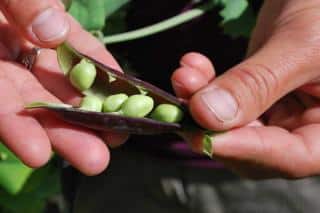

Growing green pea is quite easy and is very enjoyable. It usually starts in the spring and continues during summer.
Key pea and green pea facts
Name – Pisum sativum
Family – Fabaceae
Type – annual
Height – 1 ½ to 8 feet (50 to 250 cm)
Exposure – full sun, part sun
Soil: rich and rather moist – Harvest: end of spring → summer, 3 months after sowing
From sowing to harvest, each one of these best practices will enhance the quality of your peas.
→ Also: grow peas in containers
Peas can be sown in fall (mild climates) or at the end of winter and at the beginning of spring (harsh winters).

Sow directly in the plot:
→ Read also: green pea container growing
Onions, shallot and garlic do not make good companions for peas.
Peas love growing near certain vegetables such as: carrot, celery, cabbage, cucumber and pickle, lettuce, corn salad, turnip, potato, radish.
Peas hate these vegetables: garlic, shallot, onion, parsley, leek, tomato.
At the beginning, reduce watering in order to trigger flowering instead of foliage.
Immediately after blooming, water abundantly because that is when pods form to produce your peas.

You can harvest pea from spring to fall, depending on the variety and when you plant it.
The part of the plant that is eaten is the seed itself. It isn’t common to eat other parts of the green pea plant, not even the seed pods.
Although growing normal green pea is usually be a bit demanding, another type of pea is much easier to grow: snow pea (or summer pea).
You’ll be surprised at how fast this plant grows, it will need to be staked as soon as it has reached a few inches.
Birds love Pisum sativum seeds, and it is best to set up a net to guard against them, or you may see your harvest disappear in hours…
Light plant-based mulch will retain moisture, add organic matter and avoid weed growth.